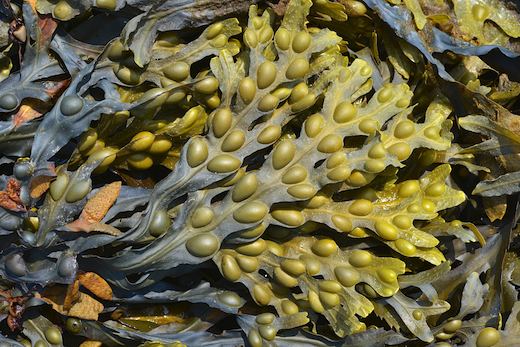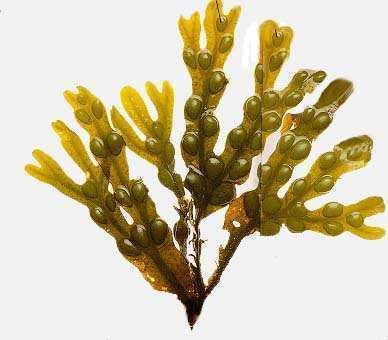Superphylum Heterokonta Higher classification Fucus | Genus Fucus Rank Species | |
 | ||
Similar Fucus, Brown algae, Ascophyllum nodosum, Fucus serratus, Kelp | ||
Bodelha fucus vesiculosus serve para estimula o funcionamento da tireoide
Fucus vesiculosus, known by the common name bladder wrack or bladderwrack, is a seaweed found on the coasts of the North Sea, the western Baltic Sea, and the Atlantic and Pacific Oceans, also known by the common names black tang, rockweed, bladder fucus, sea oak, black tany, cut weed, dyers fucus, red fucus, and rock wrack. It was the original source of iodine, discovered in 1811, and was used extensively to treat goitre, a swelling of the thyroid gland related to iodine deficiency.
Contents
- Bodelha fucus vesiculosus serve para estimula o funcionamento da tireoide
- Alternative medicine herbal remedies health risks of fucus vesiculosus
- Description
- Distribution
- Ecology
- Biology
- Consumption
- Medical use
- References
Alternative medicine herbal remedies health risks of fucus vesiculosus
Description
The fronds of F. vesiculosus grow to 90 centimetres (35 in) long and 2.5 centimetres (1.0 in) wide and have a prominent midrib throughout. It is attached by a basal disc-shaped holdfast. It has almost spherical air bladders which are usually paired, one on either side of the mid-rib, but may be absent in young plants. The margin is smooth and the frond is dichotomously branched. It is sometimes confused with Fucus spiralis with which it hybridises and is similar to Fucus serratus.
Distribution

Fucus vesiculosus is a common large alga on the shores of the British Isles. It has been recorded from the Atlantic shores of Europe, Northern Russia, the Baltic Sea, Greenland, Azores, Canary Islands, Morocco and Madeira. It is also found on the Atlantic coast of North America from Ellesmere Island, Hudson Bay to North Carolina.
Ecology

The species is especially common on sheltered shores from the middle littoral to lower intertidal levels. It is rare on exposed shores where any specimens may be short, stunted and without the air vesicles. F. vesiculosus supports few colonial organisms but provides a canopy and shelter for the tube worm Spirorbis spirorbis, herbivorous isopods, such as Idotea and surface grazing snails such as Littorina obtusata. Phlorotannins in Fucus vesiculosus act as chemical defences against the marine herbivorous snail Littorina littorea. Nevertheless, galactolipids, rather than phlorotannins, act as herbivore deterrents in this species against the sea urchin Arbacia punctulata. Methyl-jasmonate may induce the phlorotannins production. Fucophlorethol A is a type of phlorotannin found in F. vesiculosus.
Biology

Plants of F. vesiculosus are dioecious. Gametes are generally released into the seawater under calm conditions and the eggs are fertilised externally to produce a zygote. Eggs are fertilised shortly after being released from the receptacle. A study on the coast of Maine showed that there was 100% fertilisation at both exposed and sheltered sites. Continuously submerged populations in the Baltic Sea are very responsive to turbulent conditions. High fertilisation success is achieved because the gametes are only released when water velocities are low.
Consumption

Primary chemical constituents of this organism include mucilage, algin, mannitol, beta-carotene, zeaxanthin, iodine, bromine, potassium, volatile oils, and many other minerals.
Some people may suffer an allergic reaction to the iodine in bladder wrack.
Medical use
Recently the researchers found that an extract of Fucus vesiculosus, promotes the contraction of fibroblast-populated collagen gels through increased expression of integrin molecules. In this study, they investigated the effects of topical application of an aqueous extract of this alga on the thickness and the mechanical properties of human skin. A gel formulation that included 1% of the extract was applied topically to human cheek skin twice daily for five weeks. A significant decrease in skin thickness measured by B-mode ultrasound was elicited, as was a significant improvement in elasticity measured with a Cutometer as compared with controls. In cheek skin, the thickness normally increases and the elasticity usually decreases with age. These results suggest that the Fucus vesiculosus extract possesses anti-aging activities and may be useful for a variety of cosmetics.
